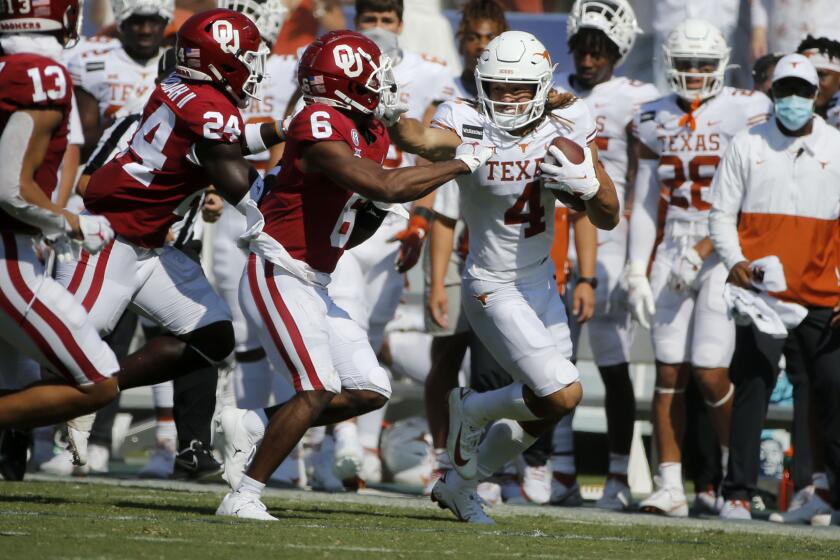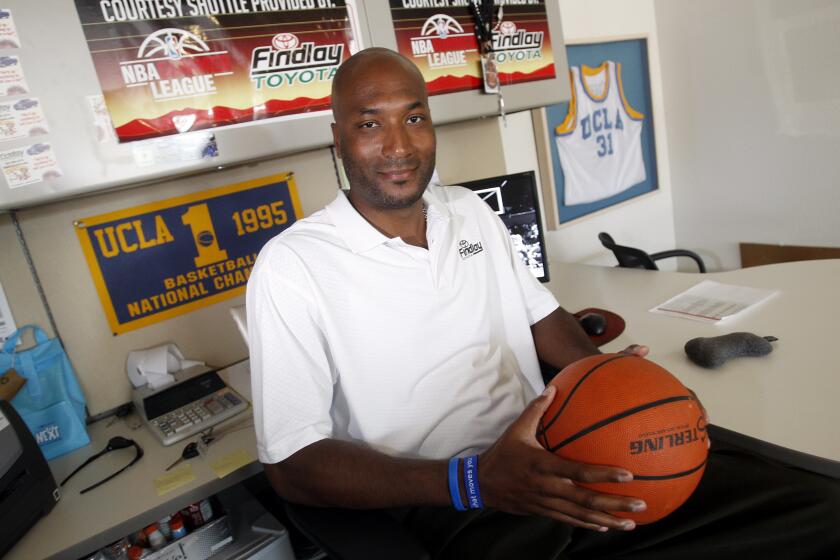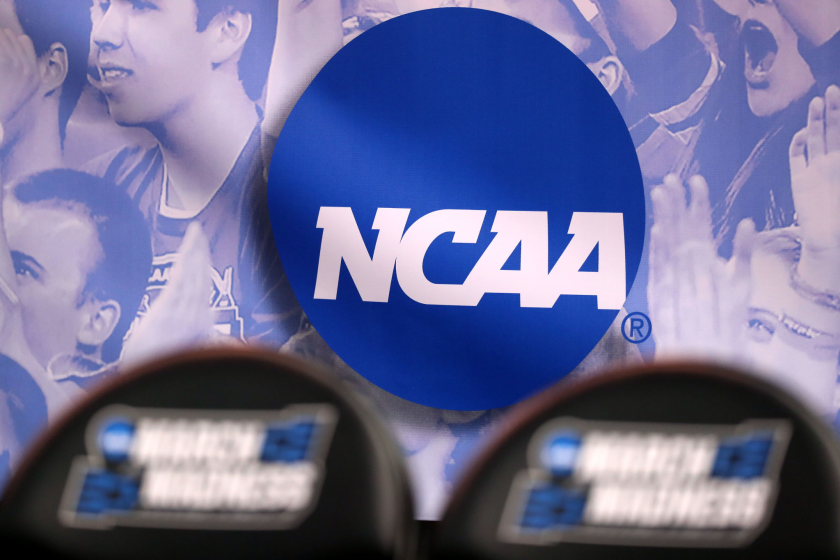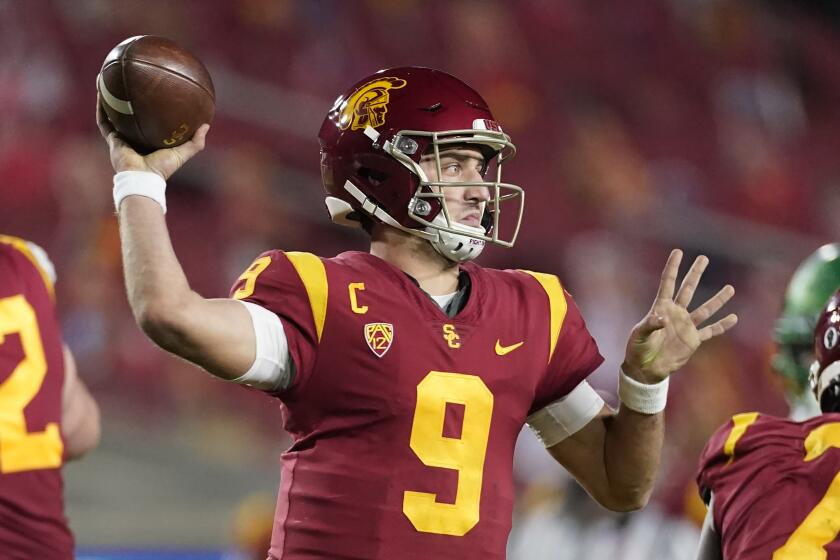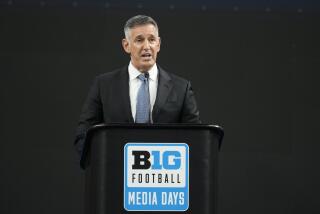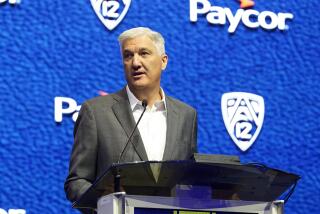Commentary: Surprise! Pac-12 can be a winner in this round of conference realignment
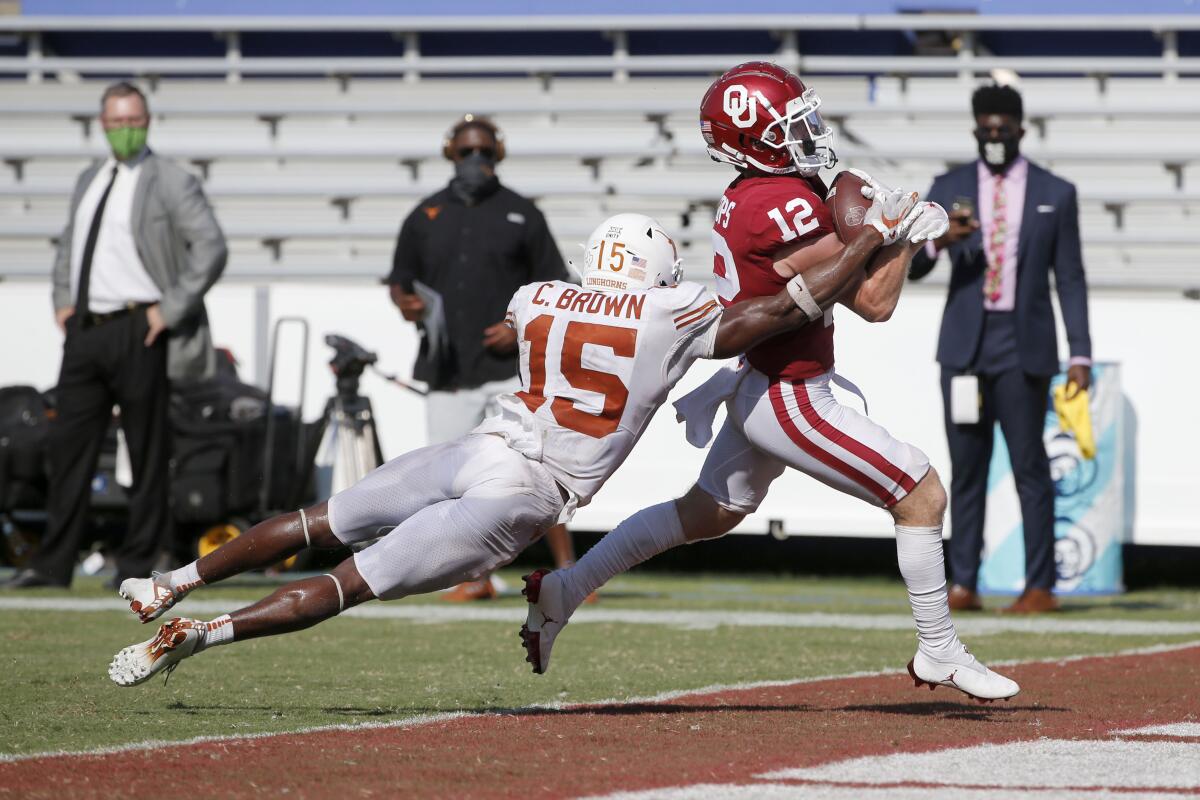
- Share via
A five-day stretch in the summer of 2010 sent the Pac-12 on a crash so calamitous the conference is still trying to hit the eject button more than a decade later.
On June 10, the NCAA released its sanctions against USC football, leveling the league’s premier brand for years to come. On June 14, the University of Texas told then-hotshot-Pac-12 commissioner Larry Scott that it was staying in the Big 12, ending the dream of a 16-team “superconference” based west of the Mississippi, where Oklahoma Sooners and Washington Huskies slept under the same roof.
For the record:
9:02 a.m. July 23, 2021A previous version of this article misidentified the site of the SEC football media days as Birmingham, Ala. The meetings were held in Hoover, a Birmingham suburb.
The losses, both real and perceived, have piled up since. There’s no need to be redundant in recounting them. But this week, as college football turned upside down with midsummer realignment déjà vu thanks once again to the ever-cantankerous pair of Bevo and Boomer, the Pac-12 may have picked up a big win this time without even playing the game.
So Texas and Oklahoma now want to join the Southeastern Conference. At the very least, they have not denied the report from the Houston Chronicle that took a blow torch to what was supposed to be a routine session of SEC media day banter Wednesday in Hoover, Ala.
A move this massive won’t just happen overnight — SEC bylaws state that 11 of the 14 schools have to vote yes on expansion, and UT’s bitter rival, Texas A&M, is definitely a “no” — but for the sake of argument let’s assume it happens.
Texas and Okahoma have reportedly expressed interest in leaving the Big 12 to join the Southeastern Conference.
Alabama, Louisiana State, Florida, Georgia, Texas, Oklahoma, Auburn, Tennessee, Texas A&M … in the same league? At a time when the College Football Playoff appears poised to expand to 12 teams? It wouldn’t be a surprise if the SEC filled half the CFP bracket.
And yet, the Pac-12 should be elated. Because it just became the third- or fourth-most important conference in college athletics.
The Big 12 is done. It only exists to placate Texas and drink off Bevo’s milk. The remaining schools, with proud traditions and rabid fan bases of their own, will have no choice but to scatter. It would be sad. Maybe the Big Ten or Atlantic Coast Conference throws a few a lifeline, but there’s no compelling reason they should.
And the Pac-12 shouldn’t, either.
New Pac-12 commissioner George Kliavkoff tweeted Wednesday just minutes after the news of Texas and Oklahoma’s flirtation with the SEC, “Just when I thought my first month on the job could not get more interesting .… ”
More like Glee-avkoff. He’s right too. This is fascinating, and it likely goes far beyond the Longhorns and Sooners getting greedy or stir-crazy or just really wanting to rancor the Aggies.
Ed O’Bannon Jr. spearheaded the NCAA’s name, image and likeness movement but says in a first-person piece for the Los Angeles Times that ‘the baton has been passed.’
There’s no logical move for the Pac-12 but to watch it unfold — finally — from a place of strength. Not one of Oklahoma State, Texas Christian, Baylor, Texas Tech, Kansas or Kansas State is either: a) good enough at football; b) has a big enough media market share; or c) a cultural fit to our premier big West Coast universities. What a relief.
If the league wanted to add a Mountain West school or Brigham Young, it would have already happened. BYU would bring lots of eyeballs but too many eye rolls for the trouble.
Just because the SEC is at 16 doesn’t mean the others have to be. The only worthy additions were Texas and Oklahoma, and the Pac-12 has had to live with the ramifications of that whiff for far too long.
It’s time to let go. Everything in college sports is changing so fast. Athletes’ freedom to make money off their name, image and likeness is just the beginning. When the NCAA punted on new NIL rules last month after two years of working group nonsense, coming on the heels of the Supreme Court’s damning ruling against the schools in NCAA vs. Alston, the Power Five lost its patience with NCAA president Mark Emmert and the board of governors.
Staring down the barrel of a July 1 effective date for name, image and likeness laws in states across the country, the NCAA finally ceded control Monday.
SEC commissioner Greg Sankey — the closest thing college football has to a czar — was vocal this week that the NCAA has not done its job on a number of fronts. Wouldn’t this seem the right time for the Football Bowl Subdivision, led by the SEC, to escape NCAA governance and start a new governing body with rules and structure that better reflect the reality that this sport has already been professionalized?
The suspicion here is that UT and OU to the SEC is a symptom of a larger systemic problem that those schools believe Sankey and the SEC can answer in the coming years better than the Big 12.
Of course, there is much to figure out about the logistics of an FBS exodus. Most crucial to the rest of Division I, would the NCAA maintain control over men’s basketball and the $1-billion pie that keeps the cartel in Indianapolis humming along and its attorneys’ bank accounts overflowing? (Also, shoot, we all love March Madness, and I can’t imagine the Power Five wants out of one of sports’ greatest spectacles).
USC quarterback Kedon Slovis has signed a deal with Klutch Sports to represent him on all NIL matters.
But the Pac-12 wouldn’t have to lose sleep over any of that. As one of only four conferences still featuring schools with national football brands, it will maintain a key seat at the table. Whatever the noise to the east, Kliavkoff would be smart to keep the focus inward on rebuilding the league’s football infrastructure and working some media rights magic before the current contracts expire in 2024.
On the more global topics, Sankey could have an ally in Kliavkoff, who has built his career in technology and entertainment through forward thinking, not hanging back. College football couldn’t be more innovative than saying goodbye to the NCAA.
More to Read
Go beyond the scoreboard
Get the latest on L.A.'s teams in the daily Sports Report newsletter.
You may occasionally receive promotional content from the Los Angeles Times.

